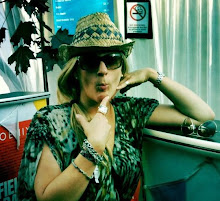I can't for the life of me remember who taught me traditional, copperplate calligraphy when I was a young, teenage whippersnapper. But, I do remember that I loved my classic fountain pen set with all the different golden nibs. Then there were those silly little tubes of coloured ink that I would inevitably get all over my fingers whilst screwing them in and out of the pen chamber. I liked the precision you had to have to write each letter, it slowed me down when I would normally write super fast and scrawly. I can still do it now and it looks ok, but there seems to be something so old-fashioned about classic calligraphy. I think it can look almost medieval or gothic. So when a friend suggested doing a modern calligraphy course for my blog, I loved the idea.
On a delightfully pretty street just off Pentonville Road there is a cluster of gorgeous design stores including
Quill; the most beautifully chic stationary shop that stands ever so clean, crisp and wonderfully inviting. It is the type of shop where I'd like to buy everything in there, but would spend a small fortune on nothing. It is also where the exceptionally talented
Megan Riera teaches her modern calligraphy workshops.

About ten of us sat at a beautifully laid out long table with everything we needed for the afternoon; paper, pen, quill, a pot of ink and Megan's guide to mastering the strokes and letters. She began by asking us if any of us had learnt calligraphy before. I was surprised that I was the only one. Did that mean I was going to flourish in this workshop? Somehow I was a little reticent looking at all the stunningly, beautiful words beneath me.
The differences with some calligraphy is the type of pen used; whether you use a classic modern-day flat-headed pen, which is more about the turn, or a traditional pointy edge pen that is based on pressure. I had always been taught with the flat-headed pen but in the workshop we were going to be using the dip pen with pointy edge. Its potentially a little harder to use these and more work but they can create much more flourishing curves and strokes.
Megan began by taking us through her guide and showing us how to effectively hold the pen and draw with the nib. With this type of pen, whenever you are drawing down, you should use pressure on the nib and therefore a thicker line emerges. Whenever the stroke goes up, you should be a lot lighter on the pressure. So, thick downstrokes, thin upstrokes. This is the fundamental rule of calligraphy.



After us all getting started and practising lines, circles, strokes and patterns, we moved onto lettering. This is where I really started to realise that my execution was really rather clunky and quite frankly, a bit childlike. It was as if I couldn't get out of the method I had already been taught. My go-to lettering was how I remembered and each time I would try to relax and make a much more freeing stroke, it just looked messy. Some of the letters I could do well but mostly I just struggled, trying to forget everything I had been taught. Surprisingly, none of the other girls seemed to be battling as much as me.


After a coffee break, we moved onto writing whole words and this is where I really drowned. Having to totally extricate myself from everything I had learnt in the past, try and relax and join all my letters up was just too much to deal with and I think there might have been a small wail emanating from my throat. Everyone was writing their name and I suddenly remembered how utterly difficult it actually is to write Joanna in any form of calligraphy. Obviously Megan reeled it off like a magical fairy writing in mid-air.


Her writing was just so effortless and she could write the words in so many different ways, all of which were more gorgeous than the last. It frustrated me so much that the more I tried the worse I seemed to get. Obviously my internal struggles with finding perfection are never quite suppressed. Ironic then, that one of the phrases I had thought about ahead of the workshop to write exquisitely was all about just that. I asked Megan if she would write it for me and then I could use it as a guide to write myself. The difference is quite perfectly apparent.
Even though I was pretty useless, it was still a lovely workshop. I might even try and practise at home in an attempt to evolve the writing, at least, from a spider scrawl to something clear and remotely graceful. (But not perfect).













0 Comments:
Post a Comment